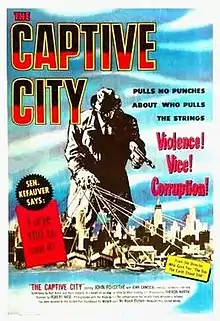The Captive City (1952 film)
The Captive City is a 1952 American film noir crime film directed by Robert Wise and starring John Forsythe.[1] The screenplay is based on real life experiences of Time magazine reporter Alvin M. Josephy, Jr., who co-wrote the script.[2]
| The Captive City | |
|---|---|
 Theatrical release poster | |
| Directed by | Robert Wise |
| Produced by | Theron Warth |
| Screenplay by | Karl Kamb Alvin M. Josephy (as Alvin M. Josephy Jr.) |
| Story by | Alvin M. Josephy (as Alvin M. Josephy Jr.) |
| Starring | John Forsythe |
| Music by | Jerome Moross |
| Cinematography | Lee Garmes |
| Edited by | Robert Swink |
Production company | Aspen Productions Avernus Productions |
| Distributed by | United Artists |
Release date |
|
Running time | 91 minutes |
| Country | United States |
| Language | English |
Plot
Newspaper editor Jim Austin and his wife are fleeing Kennington, where they live and work, so that he may testify before a committee investigating how crime impacts commerce throughout the country. They are being pursued by the criminal element from their town and pull off the highway in a place called Warren, where they take refuge in a police station. Austin requests an escort to ensure they arrive safely at the committee location. He also gets permission to use the station's tape recorder, on which he chronicles the events which have brought him to this point.
Austin is driven to investigate corruption after Clyde Nelson, a local private detective, working on an apparently harmless divorce case, discovers the existence of a big-time gambling syndicate operating with the consent of the city fathers, the local police, and the respectable elements of the community. Nelson is killed in a hit-and-run which appears to be an accident. Austin thinks otherwise and looks into the death. Throughout the course of his investigation, he is harassed and threatened; when others decide to help, they also suffer.
Cast
- John Forsythe as Jim Austin
- Joan Camden as Marge Austin
- Harold J. Kennedy as Don Carey
- Marjorie Crossland as Mrs. Sirak
- Victor Sutherland as Murray Sirak
- Ray Teal as Chief Gillette
- Martin Milner as Phil Harding
- Geraldine Hall as Mrs. Nelson
- Hal K. Dawson as Clyde Nelson
- Ian Wolfe as Rev. Nash
- Gladys Hurlbut as Linda Purcy
- Jess Kirkpatrick as Anderson
- Paul Newlan as Krug
- Frances Morris as Mrs. Harding
- Paul Brinegar as Police Sergeant
- Paul Goldwater as Sally Carey
- Robert Gorell as Joe Berg
- Glenn Judd as Coverly
- William C. Miller as Coroner
Background
The screenplay of The Captive City was inspired by the Kefauver Committee's hearings.[3] The television broadcast of the hearings attracted huge public interest and educated a broad audience about the issues of municipal corruption and organized crime. The tremendous success of the broadcast led to the production of a whole cycle of "exposé" crime films dealing with the dismantling of complex criminal organizations by law enforcement.[4][5] The Captive City had the blessing of senator Kefauver himself: Robert Wise took a print of the film to Washington D. C. to show to senator Kefauver, who not only endorsed it but even appears in the prologue and epilogue, cautioning audiences about the evils of organized crime.[6] Other notable examples of exposé films include Hoodlum Empire (1952) and The Turning Point (1952).
References
- The Captive City at IMDb.
- The Captive City at AllMovie
- Spicer, Andrew (2010). Historical Dictionary of Film Noir. Scarecrow Press. p. 47. ISBN 978-0-8108-7378-0.
- Spicer, Andrew (2010). Historical Dictionary of Film Noir. Scarecrow Press. pp. 47–48. ISBN 978-0-8108-7378-0.
- Dickos, Andrew (2002). Street with No Name: A History of the Classic American Film Noir. The University Press of Kentucky. pp. 203–206. ISBN 978-0813122434.
- "The Captive City film article". at tcm.com. Retrieved 2014-08-22.